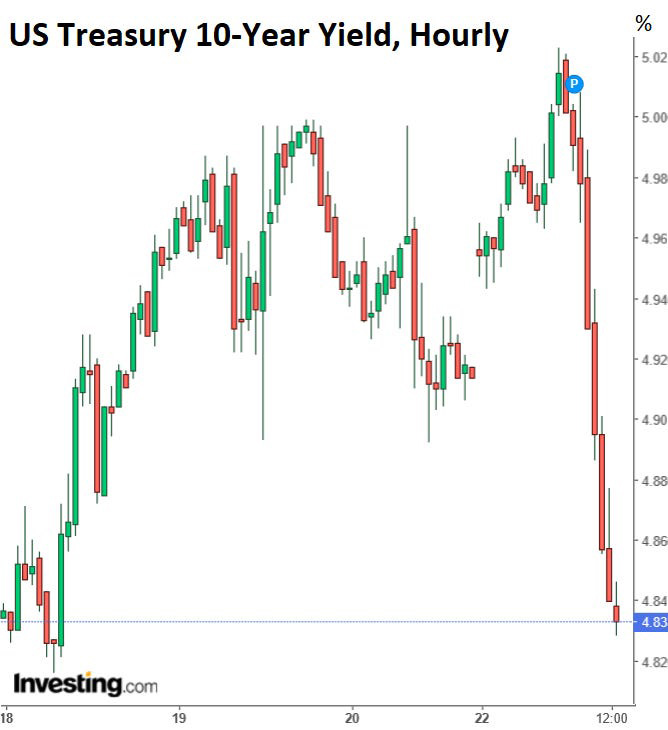The Vigilantes are Back!
David Haggith
 With the vigilantes having raised bond yields above 5%, the Big Bond Bust went BANG! today and blew a lot of money out of other markets in one big shot. With the vigilantes having raised bond yields above 5%, the Big Bond Bust went BANG! today and blew a lot of money out of other markets in one big shot.
The Vigilantes are Back!
With the vigilantes having raised bond yields above 5%, the Big Bond Bust went BANG! today and blew a lot of money out of other markets in one big shot.
I wrote the following over the weekend in my “Deeper Dive,” and this morning we already got to see it play out in spectacular style: (I’ll put in boldface the parts that happened in a blow-your-face-off way today.)
Bond instability
Others are finally seeing what the Fed isn’t. Even the liberal mainstream media are starting to sense the risks here of something truly cataclysmic forming:
Troubles are coming to the world economy — not as single spies, but as battalions.They are doing so on multiple fronts, in the United States, China and Europe. Coupled with renewed geopolitical strains in the Middle East, those troubles heighten the chances of a full-blown world economic and financial market crisis by the middle of next year.
Among the greatest threats to the U.S. and world economic recoveries is the recent spike in U.S. Treasury bond yields, the key interest rate in the world economy.
Bond investors seem to have finally escaped their stupor. As they struggle to figure out where they are, yields have become unstable — rising quickly, falling, then rising more quickly to break past mental barriers like 5% on the 10YR. Treasuries on the long end have seen the most volatile yield/price swings since 2020.
While that does not seem like far back, we have to remember what a year of economic wreckage 2020 was. It was one for the history books, built around a global pandemic and overreactions to it, and it took trillions of dollars to bail our way through it, which, along with the shortages that year handed to us because nearly everyone was forced into not working, gave us the high inflation we are still fighting today.
Naturally, with those massive changes in Fed and federal stimulus, bond rates swung considerably. Now, as mega bond trader Mohamed El-Erian says, bonds have become unanchored. No one knows what to expect anymore from what had been the world’s most liquid and stable bond market.
That unanchored sentiment is spreading:
"Markets have a fear of everything today -- call it pantophobia -- and yet that hasn't fully manifested into a panic." Bob Savage, head of markets strategy and insights, BNY Mellon.
Give it a week or two. We’ll get there. It’s not even Halloween week yet … but it’s close! Besides, “The last time US stocks were this pricey relative to the debt market, the S&P 500 crashed 50%.” So, stocks will likely soon crash down to where bond values have already gone now that bond yields have risen like they are making up for lost time.
(That was one small part of a Deeper Dive that covered many major cracks in the economy that reveal our economy is anything but “strong” and “resilient":
- The re-formation of inflation,
- Gross misreporting of inflation in CPI, distorting real GDP,
- The Leading Economic Indicators index,
- The yield curve reversion and how strongly it foretells imminent recession,
- Fed demolition of the housing market,
- The impossible situation building in US sovereign debt,
- Consumers no longer looking so strong,
- More busting banks,
- Surging corporate bankruptcies,
- Money market troubles,
- False labor market reports verified,
- The Fed’s history of creating collapse.)
Well, it took less than a week — just a day — to see that “panic” bid to safe money in bonds as the 10-YR Treasury bond once again priced above 5% early in the morning. As I had written last week, the 5% interest level on the 10Yr would be like the 100,000-mile level on your odometer that would have a major effect on sentiment in the markets. When the Maginot Line was crossed this morning, we saw how big and sudden that swing can be.
As Wolf Richter writes (probably as fast as he could this morning),
Spectacle Ensues after 10-Year Treasury Yield Pierces 5%: Huge Demand Piles in, Yield Plunges 19 Basis Points in Hours
The spectacle that everyone has been sort of waiting for happened after the 10-year Treasury yield went over 5% briefly this morning….
And, as Yahoo! published last week,
‘World’s Safest Asset’ Proves Anything But Amid Wild Treasuries
A surprisingly strong US economy and mixed signals from the Federal Reserve have fueled some of the wildest swings in Treasuries in recent memory. [Nothing compared to today’s sensation swing.] Add geopolitical angst and a surge in debt supply and you have a recipe for sustained volatility for months to come, market watchers say.
Dubbed the “world’s safest asset,” Treasuries have not lived up to that title lately as dramatic moves in yields become an almost daily occurrence. Just last week, the rate on the 10-year swung in a range of almost 40 basis points, buffeted by crosscurrents including resilient retail sales and jobless figures, a bevy of comments from Fed officials and rising demand for haven assets amid concerns of an escalating conflict in the Middle East.
“It’s going to be a rough ride, so buckle up,” Mike Schumacher, head of macro strategy at Wells Fargo Securities, said on Bloomberg TV….
“We are going to remain in this situation of great uncertainty because there is no vision as to where this economy is going,” El-Erian said on Bloomberg TV Friday
Well, today we saw that volatility kick into overdrive, and I’ll let Richter give the summation of the move:
As if someone had flicked a switch, human investors and algos that had apparently waited on the sidelines for just that moment jumped in, buying hand over fist at this signal, pushing up prices of those maturities, and thereby pushing down the 10-year yield by 19 basis points in a matter of hours, from 5.02% in early trading, to 4.83% currently, back where it had been on October 18 (hourly price chart by Investing.com):
In bond terms, a move of 19 basis points is huge. Richter provides the following chart of the huge move:
Obviously, there was no such sudden change in sentiment about the US debt; and Congress hadn’t just voted this morning to drastically reduce the budget deficit in a bipartisan manner by cutting spending and increasing taxes in some equitable manner, LOL. It was a market reaction to one of the most anticipated key numbers: the 10-year Treasury yield hitting 5%.
So, just as I wrote late last week, when the odometer, kicks over, watch out! Richter also explains why the move happened as it did. Instead of sucking money out of US stocks, it triggered the rest of the world to take a deep dive into US Treasuries as a safe haven now that they are offering yields at 5%:
Every time yields rise to meet demand, demand emerges, but a key figure like 5% for the 10-year yield triggers a special reaction – a veritable spectacle to amuse us?
This is what “resistance” is all about – lots of buying pressure emerges suddenly on a highly anticipated signal. And when that pent-up demand is sated, the 10-year yield starts rising again to where demand will be, and it will make another run for the 5%, and it may fail too as more demand emerges at this yield. But that demand may someday be sated too, and then yields would have to go higher to pull in more investors to absorb the tsunami of issuance of longer-term Treasury securities to fund the tsunami of deficits washing over the country in an inflationary environment.
I’ve referred to this as the stock-bond pump. Rising yields pump money out of stocks and into bonds, which lowers yields to an equilibrium. Then the handle on the pump rises again and lowers as money flows again from the stock pool into the bond pool. It just happened that, this time, the major money waiting unseen to move at 5% was mostly outside the country.
In other words, today’s big move pulled in a momentous pool of investors. As that move settles down, yields will rise again (because the government keeps having more and more bonds to sell); they will pass the Maginot Line again, and then they will entice in another round of investors. That time may come soon from US stocks. (Even today, the Dow, which did not respond at first but actually rose, put in a turn in the middle of the day and ended down 190 points.)
Getting the 10-year yield to trade over 5% for more than just a few moments will take some doing because there is a huge amount of global demand at this juicy yield, and it will have to be sated before the 10-year yield can go to the next level.
At the same time, a huge amount of demand will be required to absorb the tsunami of new issuance of longer-dated Treasury securities, and for now, there are no signs at all that Congress will do anything that might slow this tsunami of deficits, and therefore slow the tsunami of new issuance of longer-term debt to fund these deficits.
Not to mention all those older Treasuries the Fed keeps offloading into the market by not rolling them over so the US government has to refi them via other buyers.
Yields are rising because we are finally seeing supply come in,” Tom Tzitzouris, head of fixed income research at Strategas Research Partners said on Bloomberg Television Monday. Fed rate increases and balance-sheet reduction “is catching up with the bond market now….”
The US Treasury increased the size of its quarterly bond sales for the first time in 2 1/2 years in August, and Secretary Janet Yellen’s department is now readying its November financing plans….
Yields haven’t been this high since the era that preceded the Fed’s experiment with unconventional policies — near-zero benchmark rates and quantitative easing — aimed at shoring up an economy that had been rocked by the sub-prime mortgage crisis and collapse of Lehman Brothers. Those policies were implemented on and off for 15 years until the pandemic, and the wave of government spending it triggered, fueled an inflation surge that forced policy makers to raise interest rates closer to the norm seen for decades….
The rise in yields has humbled the giants of the financial world, some of whom predicted that 2023 would prove to be the “year of the bond….” Goldman Sachs had the most bearish forecast, calling for a year-end level of 4.3%.
Ha! Not anymore! We left 4.3% in the dust way back down the trail, and that was the most bearish of the positive beliefs about the bond market for this year in the mainstream financial media. No, this is the “Year of the Vigilante!”
As I’ve been writing frequently about the driver of the big moves we will now be seeing (and today did see), CNBC now reports …
‘The bond vigilante is coming back,’ UBS strategist says
The yield on the benchmark 10-year U.S. Treasury note rose above 5% once again on Monday, having passed the milestone on Thursday for the first time since 2007….
“The bond vigilante is coming back, so this is very important for asset prices in equity, house prices, fiscal policy, monetary policy, so no longer is this a free ride on bond markets anymore — so the government has to be very careful in terms of the future….
The term “bond vigilantes” refers to bond market investors who protest against monetary or fiscal policy they fear is inflationary by selling bonds, thereby increasing yields.
Indeed. Bond vigilantes are going to keep making the government pay handsomely for all those new bonds they issue, including the ones issued to refinance the debt the Fed will not refinance. This is one of the major reasons I gave in that “Deeper Dive” for why the economy is anything but “strong” and “resilient” right now. It is actually, for the many reasons given (the Big Bond Bust being a big one), precariously fragile right now. Nor are consumers as strong as some are claiming, and that “Deeper Dive” also gives the reasons they are not.
Now that yields have gone back down, you can expect the vigilantes to start selling again, to lift the handle of the pump back up on yields. Then buyers will see the raised handle and rush in to push it down to get those bonds, pumping money out of other markets, including the stock market as the source of cash for each round of bond purchases.
And the Fed cannot jump in because it has inflation to fight and a badly misunderstood labor market that is not giving it the leeway to jump in as the Fed keeps trusting the faulty labor gauge.
(If you happen to have read Zero Hedge, you’ll see they published several articles today, trying to put the move in bonds on Bill Ackman for announcing he was ending his bond short. However, if you look at the timing more carefully than ZH describes, you see that Ackman’s closing of his short positions was announced about twenty minutes after bond yields started falling (prices rising). The plunge in yields happened as soon bonds crossed the all-important mental boundary of 5%. That is all that triggered the plunge, and bonds crossing that line is likely what triggered Ackman to make his move, making himself much richer by selling right at the bottom of bond prices (top of yields), as many others also did. Bond yields were already about halfway down their decline (prices halfway up their sudden new rise) when Ackman announced the short he said he had just done. Sorry, by the way, that this article was later than usual; tasks at my real job got in the way. With enough supporting subscriptions, maybe someday this will become my real job.)
Please share this all-free edition of The Daily Doom to help others understand the daily doom that is washing over all of us right now as they read about it in the news.
Share
While the headlines below are free for all today and all weekday editorials are always free, you can get the headline links every weekday by becoming a paid subscriber and gain access to all past and future “Deeper Dives” where I really dig into the news. You will also help keep The Doom from meeting its own doom; but there is an option for free subscription here, too, just to get the weekday editorials:
 Seeing the Great Recession Before it Hit Seeing the Great Recession Before it Hit
My path to writing this blog began as a personal journey. Prior to the start of this so-called “Great Recession,” my ex-wife had a family home that was an inheritance from her mother. I worked as a property manger at the time, and near the end of 2007, I could tell from rumblings in the industry that the U.S. housing market was on the verge of catastrophic collapse. I urged her to press her brothers to sell the family home before prices dropped. The house went on the market and sold right away — and just three months before Bear-Stearns and others crashed, taking the U.S. housing market down for the tumble. Her family sold at the peak of the market.
www.thedailydoom.com
| 


